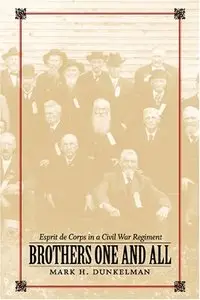Brothers One and All: Esprit de Corps in a Civil War Regiment by Mark H. Dunkelman
English | Sep. 2004 | ISBN: 080712978X, 0807131962 | 369 Pages | PDF | 2.2 MB
English | Sep. 2004 | ISBN: 080712978X, 0807131962 | 369 Pages | PDF | 2.2 MB
During the Civil War, the regiment was the fundamental component of armies both North and South, its reliability and effectiveness crucial to military success. Soldiers’ devotion to their regiment—their esprit de corps—encouraged unit cohesion and motivated the individual soldier to march into battle and endure the hardships of military life. Although historians have often remarked on the importance of esprit de corps within Civil War regiments, few have examined the phenomenon in depth.
In Brothers One and All, Mark H. Dunkelman identifies the characteristics of Civil War esprit de corps and charts its development from recruitment and combat to the end of the war and beyond through the experiences of a single regiment, the 154th New York Volunteer Infantry. Dunkelman offers a unique psychological portrait of a front-line company that fought with distinction at Chancellorsville, Gettysburg, Lookout Valley, Rocky Face Ridge, and several other engagements. Drawing on three decades of research and more than a thousand wartime letters and two dozen diaries kept by members of the 154th, he traces the evolution of natural camaraderie among friends and neighbors into a more profound sense of pride, enthusiasm, and loyalty forged as much in the shared unpleasantness of day-to-day army life as in the terrifying ordeal of battle.
Brothers One and All reveals precisely how esprit de corps gave the men of the 154th reason to keep marching and fighting despite boredom, homesickness, illness, and the death of comrades. And while Dunkelman notes the limits of regimental loyalty in instances of cowardice, malingering, and desertion, he finds that most of the men shared an abiding concern for their regiment’s reputation and honor. Even after war’s end, a strong sense of esprit de corps survived among veterans, who for decades attended regimental reunions and contributed to war memorials.
With freshness and striking effect, Dunkelman has re-created the particular experiences of the154th while offering universal insights into the nature of war and the bonds between soldiers.



